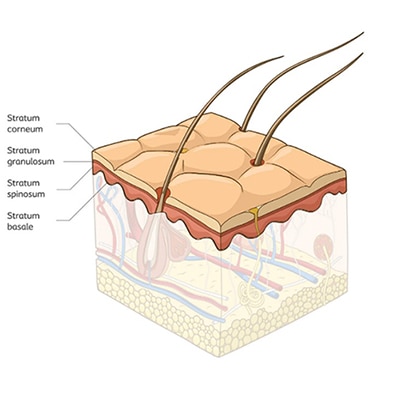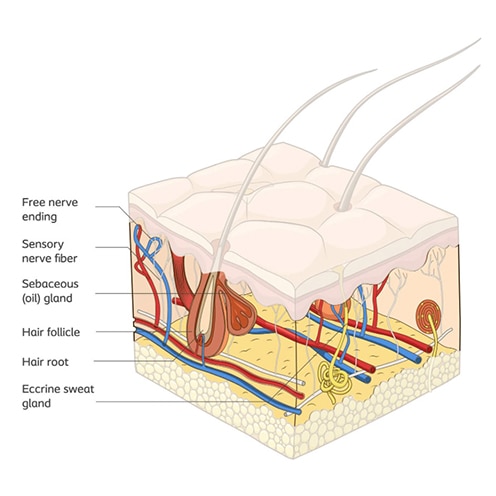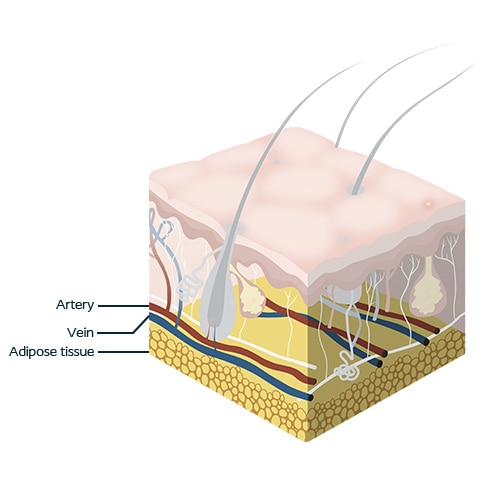Get full access with a free account
Benefits of the Coloplast® Professional Educational platform
- Full access to educational content, events and resources
- Track your progress
- Share content with your colleagues
- Share supporting material with your patient
The role of the skin
The skin’s structure plays a crucial role in wound healing. So, when we want to assess and manage wounds effectively, it’s important that we understand how the skin structure works.8
How does the skin work?
The skin's most important function is to protect our body from harm.
For example, the skin protects us from trauma, toxins, ultraviolet light and microorganisms. It also keeps us from getting dehydrated and helps our body maintain the right temperature.
Epidermis
The epidermis is the visible part of the skin – its outermost layer. The epidermis is relatively thin, ranging in thickness from 0.05 mm on our eyelids, to 1.5 mm on the palms our hands and the soles of our feet.8
This layer of skin is made up of four layers.
The top layer, the stratum corneum, is renewed about every 15 days in individuals with healthy skin.

What does the epidermis do?
The epidermis has three types of cells, each with a specific function:
- Keratinocytes - The majority of the cells in the epidermis (95%) are keratinocytes. These cells retain moisture, which helps the skin act as a barrier.33
- Melanocytes - These cells give skin its colour, or pigment. They also protect the skin from ultraviolet (UV) light.33
- Langerhans cells - These cells are a part of the immune system. They protect the body from potential allergens, bacteria and toxic substances by triggering an immune response.10,33
The three types of skin cells in the epidermis
These cells each play a roe in the epidermis' three vital functions:
- to act as a barrier
- to control water loss
- to protect our bodies from UV light, bacteria and allergens. 1, 8
Why is it important?
The epidermis is a highly specialised structure that adapts to the world around us. It provides a physical and chemical barrier that protects the body by:
- preventing foreign substances from entering the body; and
- triggering the body’s immune system when any pathogens break through the barrier.18,26
What is the dermis?
The dermis is the middle layer of the skin. It’s approximately 15-40 times thicker than the epidermis. The dermis contains nerve endings; blood vessels; and skin appendages, such as hair follicles, sebaceous glands and sweat glands.4,33
What does it do?
The dermis is responsible for many of the skin’s important functions. For example, it’s where we feel sensation, such as pain and temperature.
The dermis also contains the glands that secrete sebum, which helps the skin maintain the right moisture balance. And sebum and sweat combine to create an acidic environment on our skin, known as the “acid mantle”.33
Why is it important?

The dermis plays an important role in maintaining the skin’s moisture and pH balance. This balance helps to prevent infection. In full-thickness wounds (wounds, such as pressure injuries, that penetrate all three skin layers), the dermis is lost. That’s why these wounds take a long time to heal because the tissue repair process is so complex.19,25
Once they do heal, the structures within the dermis, such as the sweat glands and hair follicles, are permanently lost.25
Did you know?
When a wound heals, the dermis doesn’t have the same structure and function
as it does in undamaged skin. This is because the dermis is replaced by scar tissue, as you can see in this image.25
The Subcutaneous tissue
What is it?
The subcutaneous tissue, also known as subcutis, is the lower layer of the skin. This layer contains connective and fatty tissue as well as major blood vessels and nerves.33 The thickness of the subcutis depends on several factors,

including where it is on the body and the person’s age.
What does it do?
The subcutis insulates our bodies. It acts as a cushion, protecting the internal organs from external pressure. It also plays a role in helping the body retain moisture.33
Why is it important?
The subcutaneous tissue is essential precisely because of its role in insulating and padding the body. In this way, it works to protect our bones, muscles, and the organs under the skin from physical damage.
